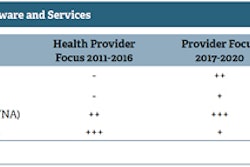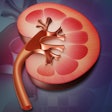"Escalating health costs, poor economic performance, and rising incidence of chronic disease are driving development of value-based healthcare in the European market."
Sound familiar?
This is one of the most consistently quoted trends attributed to healthcare investment in Europe. But how is this actually manifesting itself in the development of medical imaging and IT solutions?
Slow to embrace the digital age, the medical device industry is now playing catch up; as a result, investment in healthcare digitalization has continued to grow. Clinical departmental IT systems are starting to make way for enterprise IT solutions fronted by expansive electronic medical record (EMR) networks, in a bid to drive a holistic and connected approach to healthcare provision.
Whilst there is a long way to go to establishing true pan-European interoperability of health information, the impact of this shift is now clearly affecting medical imaging and radiology. Below, we take a look at a few specific trends in this development:
Enterprise platforms drive greater IT control
Radiologists and cardiologists have long enjoyed access to advanced IT solutions. However, increasing need for interoperability and collaboration with other clinical departments is now driving use of enterprise information systems, providing a complex conundrum: how to integrate "best of breed" solutions into larger enterprise systems?
For some, there are no decisions to be made, as decision-making power has been transferred away from clinical practitioners toward central health IT administrators. This can lead to a "one-size-fits-all" approach, with dominant hospital information systems and EMR architecture overriding and overlooking the specific needs of each clinical discipline.
Although painful for clinical specialists in the short term, this trend will not last.
In Europe especially, the focus on integrated care is increasingly more focused on specific care pathways, bringing clinicians back into the decision-making process.
Moreover, increasing investment in enterprise storage and content management is allowing a more modular approach to integration. In this architecture, a central network of storage, content management, and core medical records becomes the foundation for individual clinical IT solutions to plugin: a solution increasingly common with growth in thin-client cloud-based solutions.
If this approach is more universally adopted, a radiologist or cardiologist will be able to maintain control over their choice of clinical software, viewer, and toolset, yet also benefit from the collaboration and information sharing possible through a larger health enterprise platform. From a technological perspective, this is already possible; the challenge for most remains implementing such technology in a complex and financially restricted environment.
Clinical use expansion poses challenge for ultrasound
Outcome-based care has recently been the core focus for implementation of new IT solutions in Europe. For integration of ultrasound this is especially challenging given the rapid expansion of use in new diagnostic applications outside of radiology, cardiology, and obstetrics.
Use of ultrasound in emergency medicine, anesthesiology, ICU, surgery, vascular, and interventional settings has grown significantly in the last five years; however, few of these clinical areas offer mature, specialist, clinical IT systems that allow straightforward integration of ultrasound content. While the rollout of enterprise EMR systems will assist integration, especially in the hospital, progress and uptake has been relatively slow.
More concerning is the lack of interoperability for advanced ultrasound analysis. Premium ultrasound equipment now offers 3D images, elastography measurements, video, and audio files. These features are key benefits for ultrasound use in more advanced procedures.
However, the majority of existing PACS, RIS, and EMR systems are unable to adequately display and analyze this data. Only if these systems are underpinned by "ology-neutral" clinical content platforms (or vendor-neutral archives, VNAs, with non-DICOM capability) can advanced ultrasound content be shared and integrated into the EMR. As a consequence, more advanced use of ultrasound in newer applications could be restricted, limiting its diagnostics potential as a core imaging modality.
Advanced visualization (AV) key to adoption interventional procedures
In Europe, uptake of interventional x-ray equipment is being driven by new procedures in oncology and neurology. Procedures in both disciplines are more complex than most radiology and cardiology procedures, meaning justification is under scrutiny in terms of healthcare cost and resource.
One example in oncology is transcatheter arterial chemoembolization (TACE), where the tumor blood supply is restricted, before chemotherapeutic agents are inserted directly into the tumor area. For complex procedures such as TACE, it is essential to identify the correct blood vessels. This can be significantly sped up when aided by AV software that can bring together MRI, 3D x-ray, and CT images for correct vessel selection.
Most AV solutions are already well integrated with existing PACS. However, sharing of images between clinical disciplines, a common occurrence in oncology, is not always straightforward, relying on the existence of enterprise EMR backed by multiformat clinical content management and storage. As a consequence, adoption and clinical use of advanced interventional x-ray is interdependent with an IT infrastructure that supports AV tools, image management, and non-DICOM-format data.
Integration of dose metrics drives patient safety
Short-term growth in the European advanced imaging market (including MRI and CT) is projected to focus on replacement of CT systems. Although the benefits of CT outweigh both the high initial cost and radiation dose concerns, there is an increasing awareness of the long-term risks of repeat exposure for both patients and physicians.
Additional legislative pressure from European directives on radiation exposure has spurred on development of dose-tracking software, evident in the growth of integrated dose tracking and reporting features in the most recently released CT systems.
By inclusion of this software as standard in CT systems, dose metrics can be integrated into the EMR of each patient, including high-dose events and tracking dose-per-type of exam. This allows physicians across the clinical care setting to monitor patient dose safety, set dose alert parameters, and ensure the long-term safety of the patient.
Just scratching the surface?
The above developments can offer significant improvements in care standards and in driving integrated care. The potential offered by the digital age in eventually allowing longitudinal patient records, greater continuity, and coordination of services, and ultimately safer healthcare, is enormous.
However, in Europe there is a long way to go before this is a universal reality.
The complexity and sheer number of stakeholders involved in healthcare IT planning makes progress slow and expensive. In a weak and recovering economic climate, few governments and health providers can afford the massive investment needed for wholesale system overhaul, yet are still pushing for cheaper, more integrated care.
This ultimately leads to a confusing patchwork approach to health network overhaul for the vast majority, limiting efficiency and effectiveness both at the enterprise and departmental level.
Fundamentally, this highlights both how far we have come today, but also how far we still have to go, in reaching a truly digital and integrated European health system.
IHS Technology provides market research and consultancy services to the medical device industry.
The comments and observations expressed herein do not necessarily reflect the opinions of AuntMinnieEurope.com, nor should they be construed as an endorsement or admonishment of any particular vendor, analyst, industry consultant, or consulting group.



















